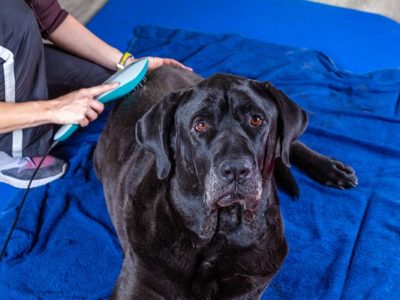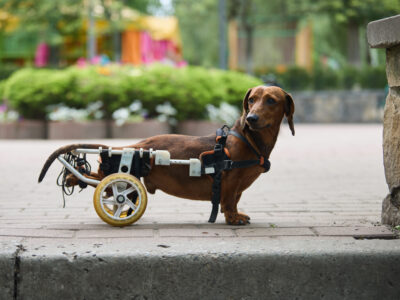The first time I heard about phantom pain in dogs was in an online support group for pet owners. My dog Sophie was suspected of having Degenerative Myelopathy, and I had joined the group to learn how to manage her symptoms.
Table of Contents[Hide][Show]

During one of our meetings, a pet mom described how she came home and found her German shepherd lying on the floor with her hind legs raw and bleeding. The dog had been chewing and biting her paws all day. The poor pet owner was devastated, but the leader of the group explained how the shepherd must be experiencing phantom pain or “neuropathic pain” in her limbs.
She said phantom pain is relatively common in dogs who’ve had an amputation, a spinal cord injury or a disease like Degenerative Myelopathy that affects the nervous system. She also told us that neuropathic pain probably happens to dogs as often as it does to humans, but it’s hard to diagnose because pets can’t tell us what they’re feeling.
Note: Every case of phantom pain is unique so please talk with your veterinarian before trying any of the treatments in this post. This post may contain affiliate links. Read our policy.
Why dogs develop neuropathic pain/phantom pain

Phantom pain happens when the nervous system is damaged through disease or trauma. It’s the body’s way of trying to regenerate the injured nerves.
When humans experience neuropathic pain, they describe it as an itch, an electrical shock, an ache, or a cramp.
Dogs, on the other hand, act out their feelings. They show signs of discomfort in these ways:
Two examples of phantom pain
One of the first symptoms dogs with the disorder show, is a repetitive scratching movement. Their leg doesn’t touch the body, but instead scratches at the air.
Dogs with the Syringomyelia can develop an array of health problems that range from deafness and blindness to tremors, seizures, and paralysis.
Dr. Marco Rosati, Assistant Professor at the Institute for Veterinary Pathology in Munich conducted a clinical study to see how often dogs with an amputated leg had these symptoms. He developed a questionnaire and asked hundreds of pet owners from the Tripawd Community to take part.
Pet owners who completed the survey, reported that 53% of dogs showed signs of pain more than one month after surgery. And about half of those canines still had symptoms of neuropathic pain up to six months after their amputation.
How phantom pain is diagnosed

Like many neurologic conditions, phantom pain is diagnosed by ruling out other health problems. Dogs undergo a complete neurologic exam that confirms or eliminates ailments such as bone cancer, spinal cord tumors and diabetes.
Once that’s done, pain medications like Gabapentin, Amantadine or Amitriptyline are often prescribed or veterinarians use a mixture of NSAIDS and pain relievers. These include: Rimadyl in combination with medications like Carprofen.
Other treatments to relieve phantom pain
In addition to medicine, veterinary professionals have been successful in reducing phantom pain with other forms of therapy.
Massage

Get the Essential Guide
The Essential Guide of Products for Handicapped Dogs e-book is a labor of love for me. I wrote it to answer your most pressing questions about where to find the best products for your wheelchair dog. You’ll find products you didn’t know existed and each will improve your dog’s quality of life. Print a copy and keep it by your side.
Reducing Electro Magnetic Frequencies (EMF)
To accomplish this task, the Farabloc company has created a pain relief dog blanket. It’s a cozy blanket made with metal mesh that scientifically blocks EMFs. In addition, the blanket increases circulation and decreases swelling.










My dog developed phantom limping. Most of the time he is fine but on and off he started to display phantom limping at home as if he can only walk with one front arm and not the other one. What should I do and what is the ultimate cure? He is a male golden doodle a bit over 2 years of age.
Mei, It sounds like your dog might benefit from a visit to your vet.